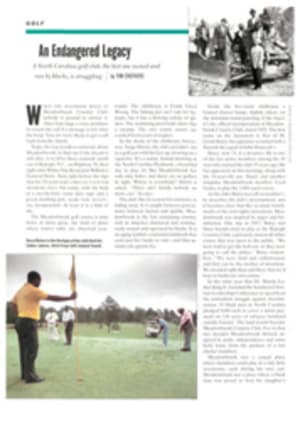
The Ultimate Bug Buster
I have entered my second childhood, and the excitement and thrills are even better than they were the first time around. After the passage of 50 years, I again find myself using a slingshot, only now I'm not after rabbits and squirrels but far different game—yellow jackets and houseflies.
I owe my reintroduction to the slingshot to my dog, Buster. A high-spirited, 90-pound black Labrador retriever, Buster suddenly got it into his head not to come back to me after a retrieve but to stop 10 feet away and have me chase him. Chasing would only have worsened the problem, so I ignored Buster and stomped into the house. After an hour or two he scratched at the door, wanting to come in. The next day he played the same stupid game. Frustrated and angry, I called Jack Cassidy, an astute retriever trainer in Middletown, N.Y., who told me to drop Buster off at his kennel.
I did, and later, when I went to bring Buster home, Jack said, "Buster doesn't play chase anymore."
"How did you stop him?" I asked.
"I stung him in the butt with a marble whenever he pulled that stuff. Here, take these along with you," he said, handing me a slingshot and a bag of marbles. The slingshot was not the kind I used to make as a boy from the crotch of a tree branch; it was made of steel and had a finger-fitting plastic grip with the manufacturer's name, Saunders, stamped on the bottom.
At home Buster attempted to act up a couple of times, but he came to his senses the instant he saw me pull out the slingshot. In the summer of 1991, with Buster no longer misbehaving, I took to shooting marbles at fence posts and tree stumps and at an old metal bucket next to the garage (there is something very satisfying in hearing a pingggg). When Ed's Variety Store on Main Street ran out of marbles, I used pebbles from the driveway. I have always been a good shot—I was an expert with the M1 rifle in the Marine Corps—but it was impossible for me to be on target with the pebbles because they veered wildly in flight.
I phoned a friend in Damariscotta, Maine, R. Ian Fletcher, a fluid dynamicist and former professor of biomathematics at the University of Washington, who explained, "A piece of gravel has an asymmetric shape. As a result, the drag is not the same at all boundaries, and vortices shed from it are chaotic, so you don't know what it's going to do."
"Wow," I said to myself, "you sound like a Yankee pitching coach." Ian added that the best projectile would be round and dimpled like a golf ball.
No such projectiles are on the market, but toward fall, our oaks began yielding a bumper crop of acorns, and I collected more than a thousand of them. Those from the red oaks, almost round and about an inch long, proved to be the best ammo. With the caps removed, they went reasonably straight for as much as 30 feet and packed enough wallop to make the bucket ring.
Several days later, while working inside the house with the door to the deck open, I suddenly jerked bolt upright with a sharp, scaring pain in the back of my neck. It was as though I had been stabbed with a long, hot needle. A yellow jacket had stung me, but before I realized what had happened and could get up to close the door, I was stabbed again, on the arm and then on the back. It turned out that workmen putting an extension on to the deck had disturbed a nest of yellow jackets, and for some reason they had attacked me instead of the workmen.
It so happens that last summer was a banner year not only for acorns but also for yellow jackets and some of the insects on which they prey. These insects included, according to another friend, Dominick Pirone, a professor of biology at Manhattan College, the caterpillars of the tiger swallowtail, monarch, painted lady and fritillary butterflies. But then as summer advanced and the caterpillars flew off as butterflies, the yellow jackets found food in short supply, and they turned nastier than usual. They stung a man to death not far from us when he accidentally ran over one of their nests with a lawn mower.
One day I happened to notice yellow jackets landing on the branches and leaves of a ficus tree on the deck near the kitchen door. They were apparently hunting for aphids and other small insects, and although they paid no attention to me as I shot at them from only six feet away, from behind a crack in the kitchen door, they would fly off when an acorn shook the leaf or branch on which they were perched. That wasn't the case, however, with the yellow jackets I saw crawling nearby on the top railing of the deck. The railing didn't quiver or shake when an acorn slammed into it, so the yellow jackets remained there, blissfully unaware of impending doom, even when an acorn missed them by a hair. And when I did hit one, not even the carcass remained. Traveling at a speed of 150 mph, the acorn would slam into the yellow jacket and blow it into oblivion. When my aim was right on, I scored at least one kill on every four to six shots, and there were times when I had two or three kills back to back.
By now I had become an enraged entomophobic Clint Eastwood, fairly shouting to myself. "Make my day, yellow jackets!" I took a teaspoonful of raspberry preserve and dolloped it on top of the rail, because as every picnicker knows, yellow jackets love sweets. The bait worked and then some. Not only did it hold the yellow jackets in place, but also others—sometimes four or live at a time, doubtless attracted by the aroma—would swarm in for a feast that would, aha!, turn out to be their last supper.
Like a U.S. senator happily-shooting ducks over a corn-baited blind on the Chesapeake, I enjoyed excellent sport until the advent of cold weather, when the workers and drones died off, which happens every fall, and the recently fertilized queens holed up to hibernate before repopulating the world in the spring. With the yellow jackets gone, I discovered new quarry: houseflies. On occasional warm, sunny days, even in the midst of winter, they would come out from whatever crevices they had secreted themselves in and land on the outside of our house to bask in the sun. On such days I would take to stalking the deck with slingshot and acorns, and in the course of an hour I would nail as many as a dozen flies, even though they, unlike yellow jackets, would take off after a near miss.
According to my hunting log, last Jan. 13 was a red-letter day. What made it memorable was not so much the temperature—a high of 52°—but a shooting technique I employed for the first time. On my initial foray onto the deck that day, I found myself off target and the flies quickly on the wing. Indeed, they seemed to spend more time flying than sunbathing, but then, happy thought, I recalled the ploy I had heard about from John Shaw, an English friend who had visited me the previous fall.
Like me, Shaw is an enthusiast of the slingshot, or catapult, as the Brits call it, and he told me how he had dealt with the adult dragonflies that were starting to fly into his new fish-rearing pond to deposit their eggs. Dragonfly eggs hatch into nymphs that live underwater for a year or more until they crawl out and emerge as winged adults. Vicious predators, the nymphs have an extendable jaw that can shoot out faster than a switchblade to seize passing prey, such as the tiny fish Shaw was raising to sell.
What to do? Shaw took a piece of toilet tissue, poured a bit of Kosher salt into the middle, folded the tissue to hold the salt, loaded the wad in the pocket of his catapult and aimed at any dragonfly that came flying in to lay its eggs in his pond. Although dragonflies are armored like helicopter gunships and are the swiftest and trickiest flyers in the insect world, they dropped dead from the hail of Shaw's toilet-paper wads of salt, which fanned out to form a pattern like that of shotgun pellets.
I had no Kosher salt on hand to down the aerially acrobatic houseflies that usually eluded my single-shot acorns, but I did have a jar on my library table of tiny lead shot, size 12, the size of the period at the end of this sentence. I loaded a pinch of the shot—this stuff is almost like dust—onto a sheet of toilet paper, carefully folded it and went back outside on the hunt, humming to myself. I took aim at the first fly I saw, a big one about the size of a horsefly. Ba-boom! The brute instantly expired in midair. Frabjous joy! All my hitherto free-flying flies literally bit the dust as I shot away.
Ever one for self-improvement, I read whatever I could And on the subject of slingshots, which was not much, and talked to experts in the field, notably 78-year-old Chuck Saunders, whose Saunders Archery Company, in Columbus, Neb., not only made the slingshot that Jack Cassidy had given me but also manufactures 95% of the slingshots made in America.
Saunders asked me how I held my slingshot. I said, "Upright, with my left hand holding the pouch about four inches in front of my nose while I aim at the target through the middle of the fork." All wrong, no matter how good I thought I was, Saunders said. "I used to do the same when I started using a slingshot, and I couldn't hit a thing," he said. "It was only because I was an archer that I saw what was wrong."
Saunders went on to say that most competitive slingshot shooters use his method, which he adapted in the '30s and '40s from archery. "Archers," Saunders explained, "anchor their bow hand to the side of their face, the hollow of the cheek, so that the hand does not float around. I adopted this system for the slingshot while holding it sideways and using the top prong for the sight."
Saunders convinced me, and I practiced his style of shooting, which was reward enough. Above and beyond that, though, I could hardly wait for Jim Rod, a wise-guy fishing and pheasant-hunting pal, to ask me what I had been up to recently. I could see myself saying, "I've taken up the slingshot, Jim." And I could just hear him saying, "You're weird, man. I'd love to be a fly on the wall when you're alone."
With that, I would chuckle and say, "Be my guest, Jim. Make my day."
TWO ILLUSTRATIONS
MARK MAREK

